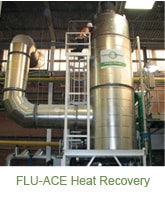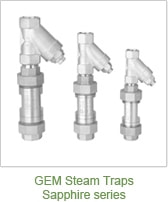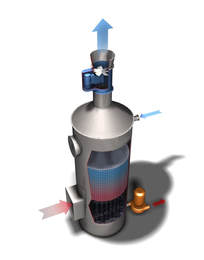 Earlier this month TEI’s Technical Director, Sam Mawby, was invited to deliver a presentation at the Richmond Energy Business Forum International. With customers actively stepping up their energy efficiency efforts in response to internal and Governmental carbon targets, Sam met with representatives from some of Europe’s biggest energy users to explain how Thermal Energy can support them in reducing their carbon emissions through TEI’s expanded portfolio of Heat Recovery solutions. Heat Recovery Technology a Great Fit for Hospitals Looking to Cut Energy Bills and GHG Emissions3/26/2018 Earlier today we announced that we received an order from a teaching hospital for one of our proprietary FLU-ACE® heat recovery systems. The FLU-ACE condensing heat recovery system is to be installed on the exhausts from two existing hot water boilers and one CHP. The waste heat will be used to generate hot water for use in hydronic heating and domestic hot water.
Based on our analysis of the information gathered on site, we expect the FLU-ACE system to provide the teaching hospital with annual savings of approximately $220 thousand, while reducing greenhouse gas emissions by 1,007 tonnes per year. Hospitals are very energy-intensive facilities In terms of Btu per square foot, inpatient health care facilities are the second most energy-intensive facility type across the United States, according to the Energy Information Administration. Just what makes them so energy-intensive? Well for starters, hospitals are open 24 hours a day and are occupied by hundreds or thousands of employees, patients, and visitors. They tend to have sophisticated heating, ventilation, and air conditioning systems to control temperatures and air flow. Moreover, many energy-intensive activities occur in hospitals: laundry, medical and lab equipment use, sterilization, food service, refrigeration, and computer and server use. Why FLU-ACE is a smart choice for hospitals About 15% to 20% of the energy used in a boiler plant is lost up the boiler stack. FLU-ACE is a direct contact condensing heat recovery system that recycles the heat normally lost through the boiler flue gas exhaust. It effectively recovers this waste energy and uses it to preheat a heat sink – this could be water for your space heating, domestic hot water, boiler feed water, or outside air heating. By replacing the existing load with our recovered energy, many hospitals have been able to prove savings of 20% on their fuel bills. Be sure to check out our case studies showing the proven benefits of our energy efficiency solutions for hospitals. Back in December we announced an $11 million energy efficiency project with Resolute FP Canada Inc. The project, which included the installation of two FLU-ACE® Heat Recovery Systems and the conversion of the mill’s steam traps to Thermal Energy’s proprietary GEM Steam Trap system, represents the Company’s largest heat recovery and largest GEM orders to date. Recently, four of our engineers went to the Resolute pulp and paper mill in Thunder Bay, Ontario to conduct an onsite survey and specification process to properly size and replace the facility’s existing mechanical traps with high-efficiency GEM Steam Traps. For more details on this project, please read our article below courtesy of ACCESS Magazine. Thermal Energy International implemented a FLU-ACE® Condensing Heat Recovery System on the pulp machine exhaust at a pulp mill in Canada. Heat sources considered for the application included boiler plant flue gas, lime kiln scrubber exhaust, smelt dissolving tank scrubber exhaust, pulp dryer exhaust, and recovery boiler exhaust. Ultimately the pulp dryer exhaust was selected due to its proximity to users, high temperature and humidity, steady flow, and low fouling potential. The FLU-ACE system was designed to deliver some 50 MMBtu/hr of energy to plant systems (peak winter performance), saving 50,000 pounds and hour of steam to be fed back into existing steam turbines to generate more electricity. This energy was previously discharged and lost to the atmosphere in the form of hot air and water vapor in the pulp dryer exhausts. The “free energy” from the exhaust was used to heat and preheat:
The system was implemented on a turn-key basis and was completed on budget and schedule. Improving energy efficiency in the industrial sector is being prioritised in many countries because of its importance in the pursuit of energy supply security, increasing economic competitiveness and in reducing greenhouse gases emissions. One of the most energy-intensive industries in North America and Europe, is pulp and paper. According to Statistics Canada, in 2014, the pulp and paper industry accounted for 24% of the total energy consumed by all manufacturing operations in the country. This was down from 31% in 2005. This decline reflects changes in the demand for certain paper products such as newsprint (Canada’s primary newsprint market, the United States, witnessed a considerable fall-off in newspaper circulation as more readers migrated to digital media sources), as well as energy efficiency improvements at various mills. Typical paper mills use most of their energy in the pulping and drying processes, but the specific energy consumption in pulp and paper production is a result of several factors, including plant size, product mix, processes used, the technical age of the mill, feedstock quality, plant capacity utilization, and climate conditions. Investment to improve energy efficiency in the pulp and paper industry can deliver large energy savings, improved productivity, and reduced environmental pollution. Opportunities to improve energy efficiency include: heat recovery, cogeneration, increased use of (self-generated) biomass fuel, and increased recycling of recovered paper, efficient motors and improved efficiency of steam use. The pulp and paper industry requires a typically high amount of power and heat in forms of hot air and/or steam. And, with such a high, steady demand for heat as well as power, many pulp and paper plants are perfectly positioned to take advantage of the benefits offered by Thermal Energy’s best-in-class heat recovery, cogeneration, and steam trap solutions.  Our FLU-ACE® heat recovery technology can recover as much as 90% of the heat normally lost through dryer section / hood exhausts in the form of water at 50°C to 70°C. This is possible using the FLU-ACE’s unique direct contact (gas/liquid) packed-tower design, enabling optimal recovery of both sensible and latent heat, in widely varying operating conditions. The pulp and paper industry remains a prime candidate for cogeneration. Thermal Energy’s Super-Efficient Cogeneration™ solutions can provide up to 70% savings on electrical costs at a self-generated kWh cost of less than $0.04/kWh, and an additional 10% to 20% natural gas energy savings from up to 90% recovery of heat losses from existing exhaust streams.  Our GEM™ steam traps help pulp and paper manufacturers achieve a 10% to 20% permanent reduction in steam costs. GEM steam traps have no moving parts, require virtually no maintenance, and come with a ten-year “no fail” performance warranty, which means increased reliability and less maintenance costs. Venturi orifice designed GEM steam traps can help eliminate water hammering problems, eliminate the cost of replacing failed traps, and improve a plant’s production output. Our pulp and paper customers recognize their social obligations and their role in the communities and countries in which they operate. In fact, many proactive forest-industry companies have brought responsible business practices visibly into their corporate strategies and communication efforts. We look forward to continuing to work with pulp and paper companies in helping them achieve their corporate energy savings and greenhouse gas reduction goals. Resulting emissions reduction expected to be equivalent to preventing the burning of more than 21 million kilograms of coal per year OTTAWA, ONTARIO– December 5, 2017 – Thermal Energy International Inc. (“Thermal Energy” or the “Company”) (TSX-V: TMG), a global provider of industrial and institutional energy efficiency solutions, has been engaged by an existing pulp and paper customer to design, develop and implement a major energy efficiency improvement and greenhouse gas reduction project. The project includes the installation of two of Thermal Energy’s proprietary FLU-ACE® Heat Recovery Systems and the conversion of the mill’s steam traps to Thermal Energy’s proprietary GEM™ Steam Trap system. Once completed, the $11 million project is expected to provide the customer with annual natural gas savings of more than 35%, while reducing its annual greenhouse gas emissions by more than 20%, or approximately 43,000 metric tonnes. “Pulp and paper is one of the most energy intensive sectors and our energy efficiency solutions represent a win-win scenario," said William Crossland, CEO of Thermal Energy. "We have been working in partnership with this customer over the past year to develop a turn-key project that meets both their energy savings and greenhouse gas reduction goals. This resulted in our largest single order to date and a project that can serve as a blueprint for other large energy users around the world looking for an optimal solution for fighting climate change, by providing significant reductions in carbon emissions and energy use while, at the same time, delivering a high return on investment.” The estimated annual reduction in greenhouse gas emissions resulting from the project, once complete, is equivalent[1] to:
This project represents Thermal Energy’s largest heat recovery and largest GEM orders to date and is expected to be substantially completed and revenue earned over the next 18 months. [1] United States Environmental Protection Agency’s Greenhouse Gas Equivalencies Calculator: www.epa.gov/energy/greenhouse-gas-equivalencies-calculator [2] The Cost of Wind Energy in the US: www.awea.org/falling-wind-energy-costs About Thermal Energy International Inc.
Thermal Energy International Inc. is an established global supplier of proprietary, proven energy efficiency and emissions reduction solutions to the industrial and institutional sectors. We save our customers money and improve their bottom line by reducing their fuel use and cutting their carbon emissions. Our customers include a large number of Fortune 500 and other leading multinational companies across a wide range of industry sectors. Thermal Energy is also a fully accredited professional engineering firm and by providing a unique mix of proprietary products together with process, energy and, environmental engineering expertise, Thermal Energy is able to deliver unique turnkey projects with significant financial and environmental benefits for our customers. Thermal Energy's proprietary products include; GEMTM - Steam traps, FLU-ACE® - Direct contact condensing heat recovery, and Dry-Rex® - Low temperature biomass drying systems. Thermal Energy International Inc. has offices in Ottawa, Canada as well as Bristol, U.K., United States, Germany, Italy and China. The Company’s common shares are traded on the TSX Venture Exchange (TSX-V) under the symbol TMG. For more information, visit our website at www.thermalenergy.com and follow us on Twitter at http://twitter.com/GoThermalEnergy. William Crossland President and CEO Thermal Energy International Inc. 613-723-6776 [email protected] Trevor Heisler Investor Relations Heisler Communications 416-500-8061 [email protected] # # # This press release contains forward-looking statements relating to, and amongst other things, based on management’s expectations, estimates and projections, the anticipated effectiveness of the Company’s products and services and the timing of revenues to be received by the Company. Information as to the amount of heat recovered, energy savings and payback period associated with Thermal Energy International’s products are based on the Company’s own testing and average customer results to date. Statements relating to the expected installation and revenue recognition for projects, statements about the anticipated effectiveness and lifespan of the Company’s products, statements about the expected environmental effects and cost savings associated with the Company’s products and statements about the Company’s ability to cross-sell its products and sell to more sites are forward looking statements. These statements are not guarantees of future performance and involve a number of risks, uncertainties and assumptions. Many factors, some of which are outside of the Company’s control, could cause events and results to differ materially from those stated. Fulfilment of orders, installation of product and activation of product could all be delayed for a number of reasons, some of which are outside of the Company’s control, which would result in anticipated revenues from such projects being delayed or in the most serious cases eliminated. Actions taken by the Company’s customers and factors inherent in the customer’s facilities but not anticipated by the Company can have a negative impact on the expected effectiveness and lifespan of the Company’s products and on the expected environmental effects and cost savings expected from the Company’s products. Any customer’s willingness to purchase additional products from the Company is dependent on many factors, some of which are outside of the Company’s control, including but not limited to the customer’s perceived needs and the continuing financial viability of the customer. The Company disclaims any obligation to publicly update or revise any such statements except as required by law. Neither TSX Venture Exchange nor its Regulation Services Provider (as that term is defined in the policies of the TSX Venture Exchange) accepts responsibility for the adequacy or accuracy of this release Governments around the world are taking unprecedented action on climate change, with some governments having legislated incentives to improve the uptake of cogeneration technology. Cogeneration has long been popular in Europe, where district heating is more common, and among self-generating industrial customers around the world. In our own backyard, the Province of Ontario has incentives in place that cover up to 40% of the capital cost of an installation. Among other eligibility criteria, the cogeneration plant must produce a minimum of 100,000 kWh for on-site consumption annually while maintaining a minimum overall system efficiency of 65% (meaning 65% of the energy from the natural gas powering the cogeneration system is used as electricity or for heating). Another factor seemingly driving interest in cogeneration is the difference between how much electricity costs from the grid and how much it costs companies to produce it themselves with natural gas. Companies are realizing that it can be cheaper to produce their own power behind the meter, although they still have to remain connected to the grid in Ontario to qualify for the government’s incentives. In addition to increased efficiency, reduced greenhouse gas emissions, and significant cost savings for users, cogeneration also offers improved energy security. If there is a grid power outage, the cogeneration unit works as a backup source, securing the supply of energy so that there is no danger of electricity supply being interrupted.
We just wrapped up three days in beautiful Las Vegas at the 2017 AHR Expo --- the largest HVACR show and marketplace in the world. The AHR Expo, which started 85 years ago as a heating and ventilation show, has grown into the HVACR event of the year and is held in major cities across the U.S.
The show was well attended by HVACR professionals serving commercial, industrial, residential and institutional markets. The event provided us with an excellent opportunity to showcase our best-in-class energy efficiency solutions, providing us with good exposure to contractors, engineers, OEMs, distributors and other industry professionals attending the Expo searching for new products and services. Thermal Energy Projects Receive Highly Commended Designation at Building Better Healthcare Awards11/11/2016  The combination of our FLU-ACE® heat recovery system and GEM™ steam traps installed at one of the Wrightington, Wigan and Leigh NHS Foundation Trust’s hospitals received the Highly Commended designation for improving sustainability and reducing energy at the 2016 Building Better Healthcare Awards. The FLU-ACE heat recovery system (ordered in January of 2015) works by drawing off the waste gasses from the hospital’s boilers instead of letting it escape up the chimney. These gasses are then put through a unique heat recovery technology that condenses the gasses, releasing all the available energy within them. This means that instead of exhausting to atmosphere at 200°C, which creates a visible “plume” of wasted energy at the boiler house, the hospital can use all the energy and exhaust at 31°C instead, making it 99% efficient. This energy is used on site to heat 20m3 of water for heating, and 6m3 of water for domestic hot water, every hour of the year. This in turn means that the boilers have to do less to keep the same amount of hot water flowing around the hospital, so the amount of natural gas used drops. We had previously installed our GEM steam traps on site. Unlike a conventional mechanical trap, our venturi orifice GEM steam traps enable continuous condensate discharge. Our traps are specifically sized to the application. Therefore the live steam loss through our GEM steam traps is significantly lower than the loss through a conventional mechanical trap. By switching to the GEM steam traps on all of the hospital’s distribution lines and processes, the same amount of hot water is produced whilst reducing steam consumption by 11%. All the new GEM steam traps are covered by a 10-year no-fail guarantee. The Trust was able to fund these projects with Salix funding, where the payments to Salix were less than the savings, meaning the hospital would be cash positive all the way through. The projects were set to reduce the Trust-wide CO2 emissions by 968 tonnes per annum, which is a remarkable 7% reduction on 2010/2011 levels, and also put the Trust firmly on track to over achieve the savings stipulated by the government. Combined, the projects were expected to provide the hospital with annual savings of approximately £170,115, mainly as a result of a reduction in fuel usage, steam savings, and maintenance savings. However, the projects achieved the financial and CO2 savings in the first eight months of the year, meaning the projects have over-performed. Based on the success of these projects, the Trust ordered an extension to the original heat recovery system (which will double its effectiveness on site and add redundancy to all of the plant rooms, making the patient environment more stable and reliable), as well as two heat recovery systems and one GEM system at the Trust’s other two hospitals. Thermal Energy International helps hospitals save money by reducing their fuel bills while also lowering their greenhouse gas emissions. Our proven solutions can increase the efficiency of your heating and steam system to as much as 95% with typical project paybacks (for our combined technologies) within three to five years. >> View case studies About the Building Better Healthcare Awards
The Building Better Healthcare (BBH) Awards are held each year to celebrate innovation and improvement in the built environment, medical devices and people working in the healthcare industry. The BBH Awards is a prestigious event run by Building Better Healthcare, which is an established information portal that provides the healthcare building community with a one-stop service for all the latest news, views, best practices, suppliers and guidance to any aspect of healthcare estates and facilities. The BBH Awards are run annually and attended by over 500 representatives from the NHS and healthcare industry.
Governments and businesses around the world are taking unprecedented action with respect to climate change. While renewable power sources and phasing out harmful hydrofluorocarbon gasses will likely play a big role in the world's fight against global warming, improving energy efficiency is perhaps the most cost-effective way to address the challenges of energy cost, energy security and global climate change. To help get the message out there, this will be the first in a series of Climate 101 blog posts and accompanying materials that discuss how improving industrial energy efficiency can make a huge difference - not only in reducing carbon emissions, but also in making businesses more profitable and competitive.
"Energy efficiency is the one energy resource that all countries possess in abundance.” - Dr. Fatih Birol, executive director of the IEA The industrial sector accounts for about one third of the total energy consumed and one-third of fossil fuel related greenhouse gas emissions in the United States. In addition to moral obligations to our planet, our children and future generations, there is clearly an ongoing need for companies to continue with their energy efficiency efforts, even with the prevailing low energy prices we are seeing today. Businesses cannot take it for granted that energy prices will continue to stay at the current low level over the medium to long term. While many industrial companies are taking some positive action, substantial energy efficiency opportunities for manufacturers still remain.
Want to help us get the message out? Share this post and/or our presentation on SlideShare using Twitter, Facebook, LinkedIn or email. Stay tuned for our next Climate 101 post on industrial heat recovery systems in the near future.
|
Archives
August 2021
Categories
All
|










 RSS Feed
RSS Feed